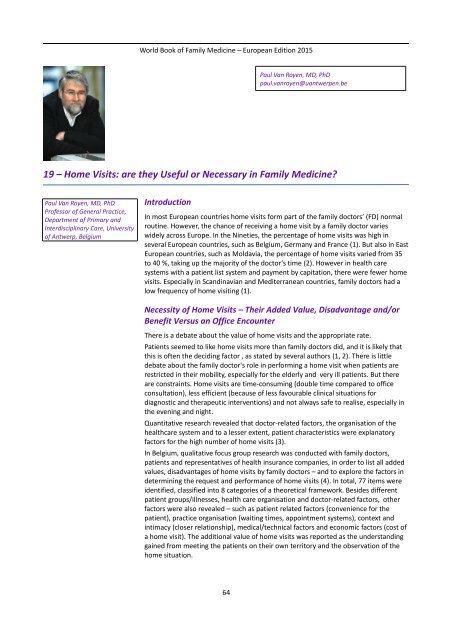Family Medicine
World Book 2015
World Book 2015
Create successful ePaper yourself
Turn your PDF publications into a flip-book with our unique Google optimized e-Paper software.
World Book of <strong>Family</strong> <strong>Medicine</strong> – European Edition 2015<br />
Paul Van Royen, MD, PhD<br />
paul.vanroyen@uantwerpen.be<br />
19 – Home Visits: are they Useful or Necessary in <strong>Family</strong> <strong>Medicine</strong>?<br />
Paul Van Royen, MD, PhD<br />
Professor of General Practice,<br />
Department of Primary and<br />
Interdisciplinary Care, University<br />
of Antwerp, Belgium<br />
Introduction<br />
In most European countries home visits form part of the family doctors’ (FD) normal<br />
routine. However, the chance of receiving a home visit by a family doctor varies<br />
widely across Europe. In the Nineties, the percentage of home visits was high in<br />
several European countries, such as Belgium, Germany and France (1). But also in East<br />
European countries, such as Moldavia, the percentage of home visits varied from 35<br />
to 40 %, taking up the majority of the doctor’s time (2). However in health care<br />
systems with a patient list system and payment by capitation, there were fewer home<br />
visits. Especially in Scandinavian and Mediterranean countries, family doctors had a<br />
low frequency of home visiting (1).<br />
Necessity of Home Visits – Their Added Value, Disadvantage and/or<br />
Benefit Versus an Office Encounter<br />
There is a debate about the value of home visits and the appropriate rate.<br />
Patients seemed to like home visits more than family doctors did, and it is likely that<br />
this is often the deciding factor , as stated by several authors (1, 2). There is little<br />
debate about the family doctor's role in performing a home visit when patients are<br />
restricted in their mobility, especially for the elderly and very ill patients. But there<br />
are constraints. Home visits are time-consuming (double time compared to office<br />
consultation), less efficient (because of less favourable clinical situations for<br />
diagnostic and therapeutic interventions) and not always safe to realise, especially in<br />
the evening and night.<br />
Quantitative research revealed that doctor-related factors, the organisation of the<br />
healthcare system and to a lesser extent, patient characteristics were explanatory<br />
factors for the high number of home visits (3).<br />
In Belgium, qualitative focus group research was conducted with family doctors,<br />
patients and representatives of health insurance companies, in order to list all added<br />
values, disadvantages of home visits by family doctors – and to explore the factors in<br />
determining the request and performance of home visits (4). In total, 77 items were<br />
identified, classified into 8 categories of a theoretical framework. Besides different<br />
patient groups/illnesses, health care organisation and doctor-related factors, other<br />
factors were also revealed – such as patient related factors (convenience for the<br />
patient), practice organisation (waiting times, appointment systems), context and<br />
intimacy (closer relationship), medical/technical factors and economic factors (cost of<br />
a home visit). The additional value of home visits was reported as the understanding<br />
gained from meeting the patients on their own territory and the observation of the<br />
home situation.<br />
64


